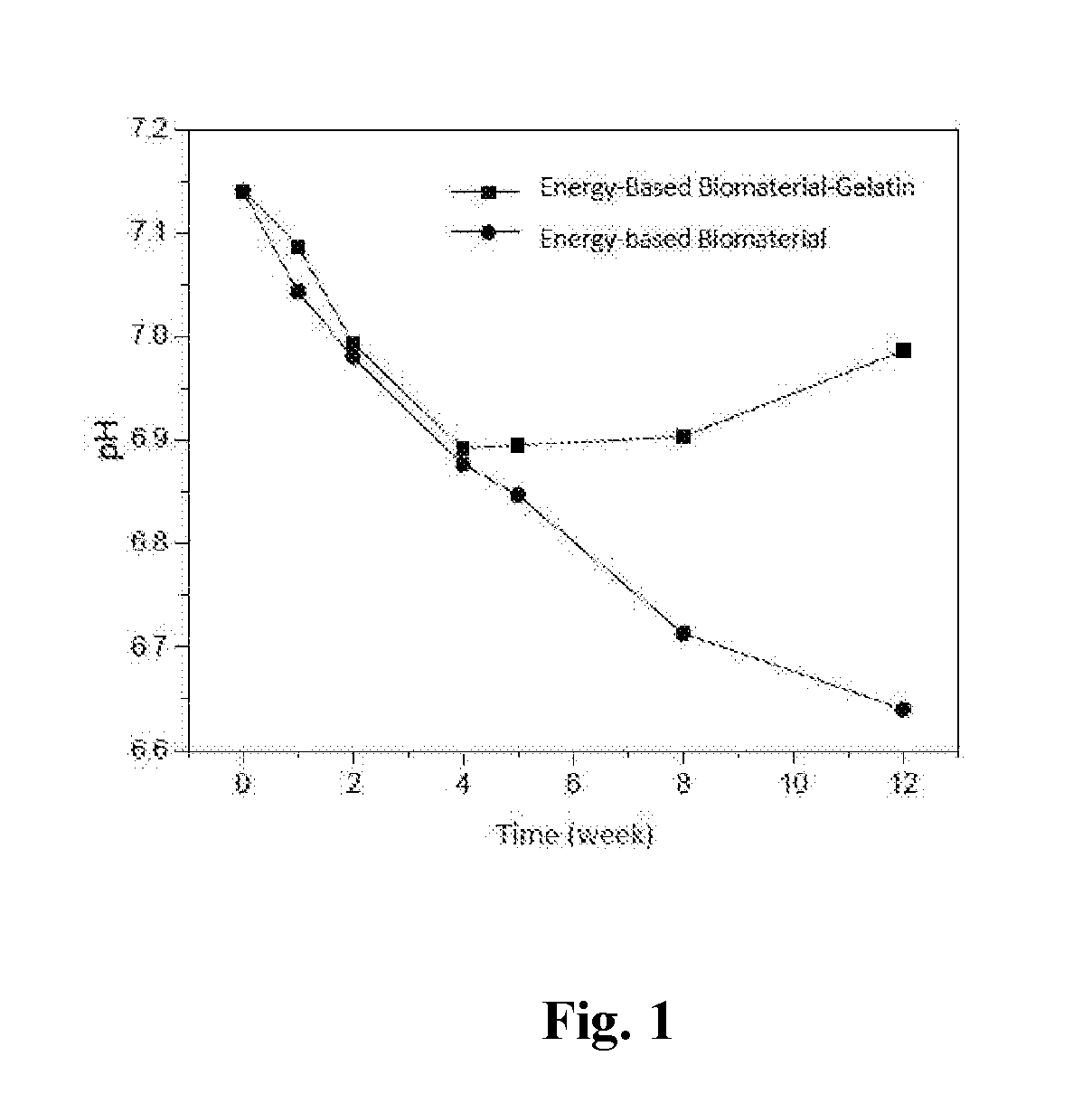Energy-Providing Bone-Repair Degradable Porous Scaffold, Preparation Method Thereof, and Application Thereof
a porous scaffold and energy-providing technology, applied in tissue regeneration, prosthesis, medical science, etc., can solve the problems of unfavorable cell growth and angiogenesis, tissue microenvironment ph reduction, etc., to facilitate cell growth, cell proliferation and tissue repair, good biocompatibility, and good biocompatibility
- Summary
- Abstract
- Description
- Claims
- Application Information
AI Technical Summary
Benefits of technology
Problems solved by technology
Method used
Image
Examples
example 1
[0054]5.90 g succinic acid, 0.56 mL glycol and 2.90 mL glycerine were mixed, reacted under stirring at 140° C. for 3 hours, and 10 mL toluene was added every 0.5 hours. The reaction was continued at a vacuum degree of −80 kPa for 10 hours to collect obtained products, and the products were made up into an acetone solution of 30 wt %. 0.5 mL of the solution was taken, into which 35 μL hexamethylene diisocyanate was added to react at 100° C. for 0.1 hours. 1 mL gelatin / dimethyl sulfoxide solution of 15 wt % was added and well-mixed, and the mixed solution was poured into a mould filled with 200 μm solid sodium chloride particles to be cured at 80° C. for 12 hours, then the sodium chloride was removed by soaking in deionized water, and finally the desired porous scaffold was obtained by using a freeze drying method. The porosity of the porous scaffold was 80%, pore size was 200 μm, and compression modulu was 1 MPa.
[0055]Rat mesenchymal stem cells were cultured on the porous scaffold of...
example 2
[0057]5.90 g succinic acid, 1.10 mL glycol and 2.20 mL glycerine were mixed, reacted under stirring at 150° C. for 2.5 hours, and 10 mL toluene was added every 0.5 hours. The reaction was continued at a vacuum degree of −90 kPa for 8 hours to collect obtained products, and the products were made up into an acetone solution of 20 wt %. 0.5 mL of the solution was taken, into which 43 μL hexamethylene diisocyanate was added to react at 90° C. for 0.15 hours. 2 mL gelatin / dimethyl sulfoxide solution of 10 wt % was added and well-mixed, and the mixed solution was poured into a mould filled with 300 μm solid sodium chloride particles to be cured at 80° C. for 12 hours, then the sodium chloride was removed by soaking in deionized water, and finally the desired porous scaffold was obtained by using a freeze drying method. The porosity of the porous scaffold was 70%, pore size was 300 μm, and compression modulu was 5 MPa.
example 3
[0058]5.90 g succinic acid, 0.28 mL glycol and 3.30 mL glycidol were mixed, reacted under stirring at 160° C. for 2 hours, and 10 mL toluene was added every 0.5 hours. The reaction was continued at a vacuum degree of −95 kPa for 6 hours to collect obtained products, and the products were made up into an acetone solution of 30 wt %. 1 mL of the solution was taken, into which 62 μL hexamethylene diisocyanate was added to react at 80° C. for 0.25 hours. 1 mL gelatin / dimethyl sulfoxide solution of 15 wt % was added and well-mixed, and the mixed solution was poured into a mould filled with 200 solid μm sodium chloride particles to be cured at 80° C. for 12 hours, then the sodium chloride was removed by soaking in deionized water, and finally the desired porous scaffold was obtained by using a freeze drying method. The porosity of the porous scaffold was 90%, pore size was 200 μm, and compression modulu was 8 MPa.
PUM
| Property | Measurement | Unit |
|---|---|---|
| Temperature | aaaaa | aaaaa |
| Temperature | aaaaa | aaaaa |
| Temperature | aaaaa | aaaaa |
Abstract
Description
Claims
Application Information
 Login to View More
Login to View More - R&D
- Intellectual Property
- Life Sciences
- Materials
- Tech Scout
- Unparalleled Data Quality
- Higher Quality Content
- 60% Fewer Hallucinations
Browse by: Latest US Patents, China's latest patents, Technical Efficacy Thesaurus, Application Domain, Technology Topic, Popular Technical Reports.
© 2025 PatSnap. All rights reserved.Legal|Privacy policy|Modern Slavery Act Transparency Statement|Sitemap|About US| Contact US: help@patsnap.com

